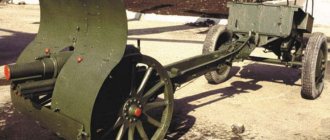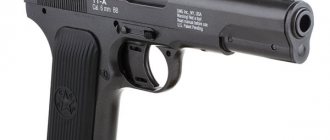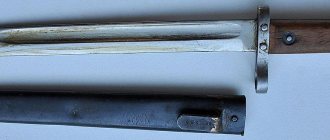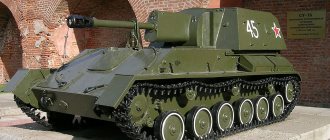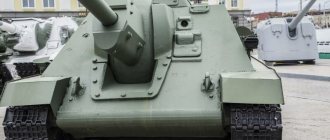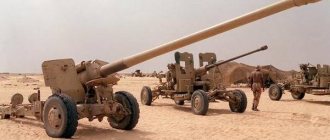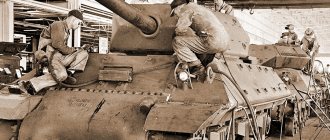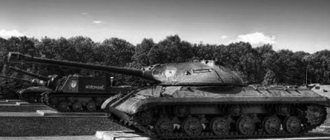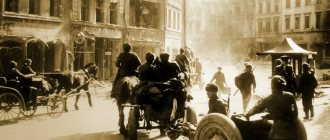Characteristics of the 160-mm mortar MT-13/M-43
A country:USSRType:MortarDate of issue:1942Calculation:Caliber:160 mmLength:3030 mm (barrel)Width:No informationWeight:1170 kg (in combat position), 1300 kg (in transport position)Rate of fire:3-4 shots/minFiring distance:630 m - 5150 mInitial projectile speed:140-245 m/secAmmunition:No information
Stories about weapons. 160-mm divisional mortar M-160 model 1949
The human brain is strange after all. As soon as Stalin’s name is mentioned in any article, a dispute immediately begins about the personality of this man and his role in the history of the USSR and the world in general. In this case, what is discussed in the article is completely unimportant. Today I will deliberately start about Stalin, more precisely, about his role in the mortar business.
“There is no modern war without mortars, mass mortars. All corps, all companies, battalions, regiments must have mortars, 6-inch ones are mandatory, 8-inch ones. This is terribly necessary for modern warfare. These are very effective mortars and very cheap artillery. A wonderful thing - a mortar. Don’t spare mines, that’s the slogan, spare your people. If you spare bombs and shells, but do not spare people, there will be fewer people. If you want us to have a war with little bloodshed, don’t spare mines.”
This is not a press appearance. This is not a speech at a rally or convention. This is not a speech intended for publication at all at a secret meeting of commanding officers to summarize the experience of combat operations against Finland on April 17, 1940. Therefore, it is not very well known to the general reader.
Even then, after a not very successful military campaign, the USSR began to seriously think about creating large-caliber mortars. The mortar as “pocket infantry artillery” became a truly special type of artillery. The opinion of I.V. Stalin was then heard by many designers and plant directors.
Immediately four design bureaus from different factories began developing large-caliber mortars. Moreover, the main calibers immediately became 160 mm and 240 mm. But work on large-caliber mortars was not a “Stalinist order.” More like a wish. Without any privileges or special responsibility for failure.
One important detail should be noted. The design bureau had no restrictions on the design of the mortar. Therefore, the projects that the designers periodically presented differed quite radically. It is enough to list some of the projects that are most famous. For some, prototypes were even created and field tests were carried out.
Muzzle-loading smooth-bore 160-mm divisional mortar "7-17", 160-mm divisional mortar IS-3, 160-mm divisional mortar of the Kukushkin system (barrel almost 2 m, mine weight 40 kg), 160-mm divisional mortar S-43...
Stalin followed the tests of new mortar models quite closely. I came to see the most successful ones in person. It was Stalin’s “personal acquaintance” with one of the mortars that led to the appearance of the most powerful mortar of the Great Patriotic War, the 160-mm MT-13, on the Soviet-German front. “Dads” of the hero of our article.
We will not describe the MT-13 mortar. Suffice it to say about the psychological impact of these weapons on the Germans. Often when these mortars fired, the enemy would sound an air raid alert. And in the battles for Berlin, MT-13s showed themselves to be a terrible weapon of destruction. It is enough that when a mine hit the roof, it “fell” 2-3 floors down and exploded there.
Despite the fact that the mortar was produced for a rather short time, from 1944 to 1947, 1,557 copies of this weapon were produced. Despite their advanced age, mortars are still in service in some armies in Southeast Asia.
Already in 1945, the designers were given the task of modernizing the MT-13 mortar. In the summer of 1945, the MT-13D mortar was introduced. At the same time, its direct competitor, the SKB-21 mortar, was tested at the Kolomna SKB GA under the leadership of B.I. Shavyrin.
During the tests, it turned out that the SKB-21 has a longer firing range and is more unpretentious in operation. Thus, it was decided to launch the SKB-21 into production. It was this mortar that received the name 160-mm divisional mortar M-160 model 1949. MT-13D was produced only in a pilot series of 4 units.
So, the Soviet 160-mm divisional mortar M-160 model 1949 is a large-caliber breech-loading artillery system that entered service with Soviet motorized rifle divisions.
The main purpose of the weapon is to destroy well-fortified long-term and field fortifications in the front line, accumulations of enemy manpower and military equipment in closed positions. The main damaging effect is achieved by firing along a steep trajectory and using high-power mines.
The 160-mm M-160 mortar is a rigid (without recoil devices), breech-loading smooth-bore system on wheels. The recoil of a shot is perceived by the ground through the base plate. To reduce the destructive effect of forces generated during a shot, the mortar has a spring shock absorber.
The mortar consists of the following main parts: a barrel with a bolt, a breech with a shock absorber, a machine with a rotating and lifting-balancing mechanisms, a boom with a winch and wheel travel, a base plate, a pivot foot and a sight.
The barrel is a smooth-walled pipe fixed in a trunnion holder, pivotally connected to a shock absorber.
The wheels are filled with sponge rubber. The mortar's spring-type suspension does not turn off when firing.
The base plate is a stamped-welded structure; it is designed to transfer the recoil force of the mortar to the ground when fired.
The pivot paw is attached to the muzzle of the barrel; it serves to connect the mortar to the tractor hook during transportation.
The mortar is equipped with an MP-46 panoramic optical mortar sight, which is mounted in the bracket of the sight leveling mechanism.
The mortar is loaded from the breech, for which the barrel is brought into the loading position (approximately horizontal) and held by the rack.
The mortar is fired using a high-explosive F-852 mine with a GVMZ-7 fuse. The fuse has settings for fragmentation and high-explosive actions. The weight of the finally loaded mine (with fuse) is 41.14 kg. The combat charge consists of a full alternating charge, a long-range charge and an igniter charge.
The design of the mine was similar to conventional 82 mm and 120 mm Soviet mines. The twelve-fin 160-mm high-explosive mine F-852 weighed 40.865 kg and contained 7.78 kg of explosive charge. Head fuze GVMZ-7.
The fundamental difference between the mortar round and all other domestic mortars was the short cartridge case into which the mine stabilizer was inserted. The sleeve was introduced to seal off the powder gases during firing.
The total alternating charge consists of an ignition charge and three additional equilibrium beams. The long-range charge consists of an ignition charge and a special additional beam. The ignition charge is inserted into the mine stabilizer tube.
Additional bundles of both alternating and long-range charges are secured to the stabilizer tube using cords. From a complete alternating charge with one, two or three additional beams, the first, second or third charge numbers are collected, respectively.
Basic data of the 160 mm M-160 mortar:
Ballistic data
Caliber - 160 mm; The longest firing range is 8040 m. The shortest firing range is 750 m. The maximum initial speed of the mine is 343 m/sec. The initial speed of the mine is the lowest - 157 m/sec.
Weight data
The weight of the mortar in firing position is 1300 kg. The weight of the mortar in the stowed position is 1470 kg. The weight of the base plate is 260 kg. The weight of the finally equipped mine is 41.14 kg.
Design data
The maximum elevation angle of the trunk is 80°. The smallest barrel elevation angle is 50°. Rate of fire - 3 shots per minute. Calculation – 7 people.
The mortar was transported by GAZ-63 and ZIL-157 towing vehicles.
Currently, M-160 mortars are in service with several armies around the world. Despite the fact that serial production of the M-160 divisional mortar was launched at two factories (plant No. 535, and since 1952 - plant No. 172) for the entire production period (production ceased in 1957), only 2353 copies were produced.
History of the creation of the MT-13/M-43 mortar
In 1942, at the Research Institute of the People's Commissariat of Armaments, under the leadership of Georgy Dmitrievich Shirenin, the development of the 160-mm breech-loading mortar MT-13 began, and from December 31, 1942, work on the mortar was headed by Isaac G. Teverovsky. Only in 1943, the future MT-13 was made as a prototype, and entered service with the USSR only on January 17, 1944, with Stalin’s personal approval.
The MT-13, or, more officially, the “ 160-mm mortar of the 1943 model ” became the most powerful Soviet (and not only Soviet - no one in the world had analogues to the MT-13) mortar of the Great Patriotic War. Its serial production began 5 days after it was put into service, and continued until August 1947.
In total, 1,557 mortars were produced during this time.
160-mm mortar M-13 model 1943
Notes
- D.F. Ustinov. In the name of Victory. M., Voenizdat, 1988. p.218
- Weapons of Victory 1941-1945 / under the general direction. ed. V.N. Novikova. M., “Mechanical Engineering”, 1985. p.94
- International Institute for Strategic Studies.
The Military Balance 2016 / James Hackett. - London: Taylor&Francis, 2016. - P. 297. - ISBN 9781857438352. - International Institute for Strategic Studies.
The Military Balance 2016 / James Hackett. - London: Taylor&Francis, 2016. - P. 239. - ISBN 9781857438352. - International Institute for Strategic Studies.
The Military Balance 2016 / James Hackett. - London: Taylor&Francis, 2016. - P. 265. - ISBN 9781857438352.
Operators
- USSR22x20px USSR
- Egypt22x20px Egypt - 30 M-160, as of 2010
- India22x20px India - about 500 M-160 units, delivered from the USSR between 1965 and 1965
- Cambodia22x20px Cambodia - some M-160, as of 2016
- PRC22x20px PRC - a number of M-160s (used under the designation Type-56), as of 2012
- Libya22x20px Libya - some M-160, as of 2012
- Mongolia22x20px Mongolia - some M-160, as of 2012
- Nicaragua22x20px Nicaragua - 4 M-160 in storage, as of 2016
- Russia22x20px Russia - 300 M-160 in storage, as of 2016
- Syria22x20px Syria - some M-160, as of 2016
Notes
Sources
- ↑ Encyclopedia of Artillery - Articles.
[https://www.artillerist.ru/modules/myarticles/article.php?storyid=209 ARTILLERY CLASSIFICATION - Classification of mortars] (Russian). Retrieved September 4, 2011. [https://www.webcitation.org/67dmDkHqp Archived from the original on May 14, 2012]. - 160-mm mortar M-160. Service manual. - M.: Military Publishing House of the USSR Ministry of Defense, 1958. - P. 128, 132. - 216 p.
- AR-27 radio fuse. Service manual. - M.: Military production of the USSR Ministry of Defense, 1974. - P. 3. - 19 p.
- The Military Balance 2010. - P. 248.
- [https://armstrade.sipri.org/armstrade/page/trade_register.php Stockholm Internation Peace Research Institute - Arms Transfers Database]
- ↑ International Institute for Strategic Studies.
The Military Balance 2016 / James Hackett. - London: Taylor&Francis, 2016. - P. 239. - 504 p. — ISBN ISBN 9781857438352. - The Military Balance 2012. - P. 235.
- The Military Balance 2012. - P. 337.
- [https://www.globalsecurity.org/military/world/mongolia/army-equipment.htm Mongolia Army Equipment] (English). Retrieved February 14, 2013.
- International Institute for Strategic Studies.
The Military Balance 2016 / James Hackett. - London: Taylor&Francis, 2016. - P. 406. - 504 p. — ISBN ISBN 9781857438352. - International Institute for Strategic Studies.
The Military Balance 2016 / James Hackett. - London: Taylor&Francis, 2016. - P. 190. - 504 p. — ISBN ISBN 9781857438352.
Links
Reserve Artillery of the Supreme High Command
| Mortars | 240 mm mortar mod. 1950 (M-240) 240-mm mortar 2S4 “Tulip” |
| Cannon | 180 mm S-23 cannon · 203 mm 2S7 "Pion" cannon |
| Howitzer | 203 mm howitzer B-4M |
| Reactive | 300 mm BM-30 “Smerch” |
Flak
| Large caliber | 152 mm KM-52 gun |
| Medium caliber | 85 mm KS-18 anti-aircraft gun · 100 mm KSM-65 anti-aircraft gun · 100 mm KS-19 anti-aircraft gun · 130 mm KS-30 anti-aircraft gun |
| Small caliber | 23 mm ZU-23 cannon · 23 mm ZSU-23-4 "Shilka" · 57 mm S-60 automatic cannon · 57 mm ZSU-57-2 · 30 mm 2S6 "Tunguska" · 30 mm 96K6 "Pantsir-S1" |
Naval artillery
Naval artillery
| MLRS | A-215 "Grad-M" · A-22 "Fire" · A-223 "Snow" |
| > 99mm | SM-2-1 AK-100 A-190 AK-130 A-192 |
| > 57mm | SM-24-ZIF · ZiF-31 · ZiF-75 · AK-725 · AK-726 · AK-176 · A-220 · A-220M |
| > 20mm | U-23 · 84-KM · 2M-3 · 2M-8 · 70-K · V-11 · SM-20-ZIF · AK-230 · AK-630 · 6K30GSh · AK-630M-2 |
Coastal artillery
| Stationary | MB-3-12 MB-2-180 MU-1 |
| Movable | KSM-65 SM-4-1 SM-9-1 BR-108 A-222 “Bereg” DP-62 “Damba” |
